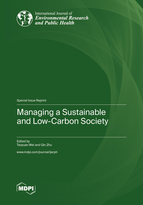Managing a Sustainable and Low-Carbon Society
A special issue of International Journal of Environmental Research and Public Health (ISSN 1660-4601). This special issue belongs to the section "Anthropogenic Circularity".
Deadline for manuscript submissions: closed (30 April 2023) | Viewed by 29949
Special Issue Editors
Interests: economics; energy transition; climate change; green accounting; general equilibrium model
Special Issues, Collections and Topics in MDPI journals
Special Issue Information
Dear Colleagues,
Modern society faces various global and regional challenges including climate change, poverty, disease, and an aging population. To deal with these challenges, society has to be managed properly to follow a sustainable and low-carbon pathway. This Special Issue welcomes theoretical and empirical studies on issues including, but not limited to: economic analysis of the sustainable energy market, the influence of population dynamics on greenhouse gas emissions, climate mitigation policy analysis, air pollution reduction, sustainable waste treatment, and low-carbon lifestyle analysis.
Dr. Taoyuan Wei
Prof. Dr. Qin Zhu
Guest Editors
Manuscript Submission Information
Manuscripts should be submitted online at www.mdpi.com by registering and logging in to this website. Once you are registered, click here to go to the submission form. Manuscripts can be submitted until the deadline. All submissions that pass pre-check are peer-reviewed. Accepted papers will be published continuously in the journal (as soon as accepted) and will be listed together on the special issue website. Research articles, review articles as well as short communications are invited. For planned papers, a title and short abstract (about 100 words) can be sent to the Editorial Office for announcement on this website.
Submitted manuscripts should not have been published previously, nor be under consideration for publication elsewhere (except conference proceedings papers). All manuscripts are thoroughly refereed through a single-blind peer-review process. A guide for authors and other relevant information for submission of manuscripts is available on the Instructions for Authors page. International Journal of Environmental Research and Public Health is an international peer-reviewed open access monthly journal published by MDPI.
Please visit the Instructions for Authors page before submitting a manuscript. The Article Processing Charge (APC) for publication in this open access journal is 2500 CHF (Swiss Francs). Submitted papers should be well formatted and use good English. Authors may use MDPI's English editing service prior to publication or during author revisions.
Keywords
- sustainable development
- low-carbon society
- management strategy
- climate mitigation and adaptation
- aging population
- waste treatment
- air pollution reduction







